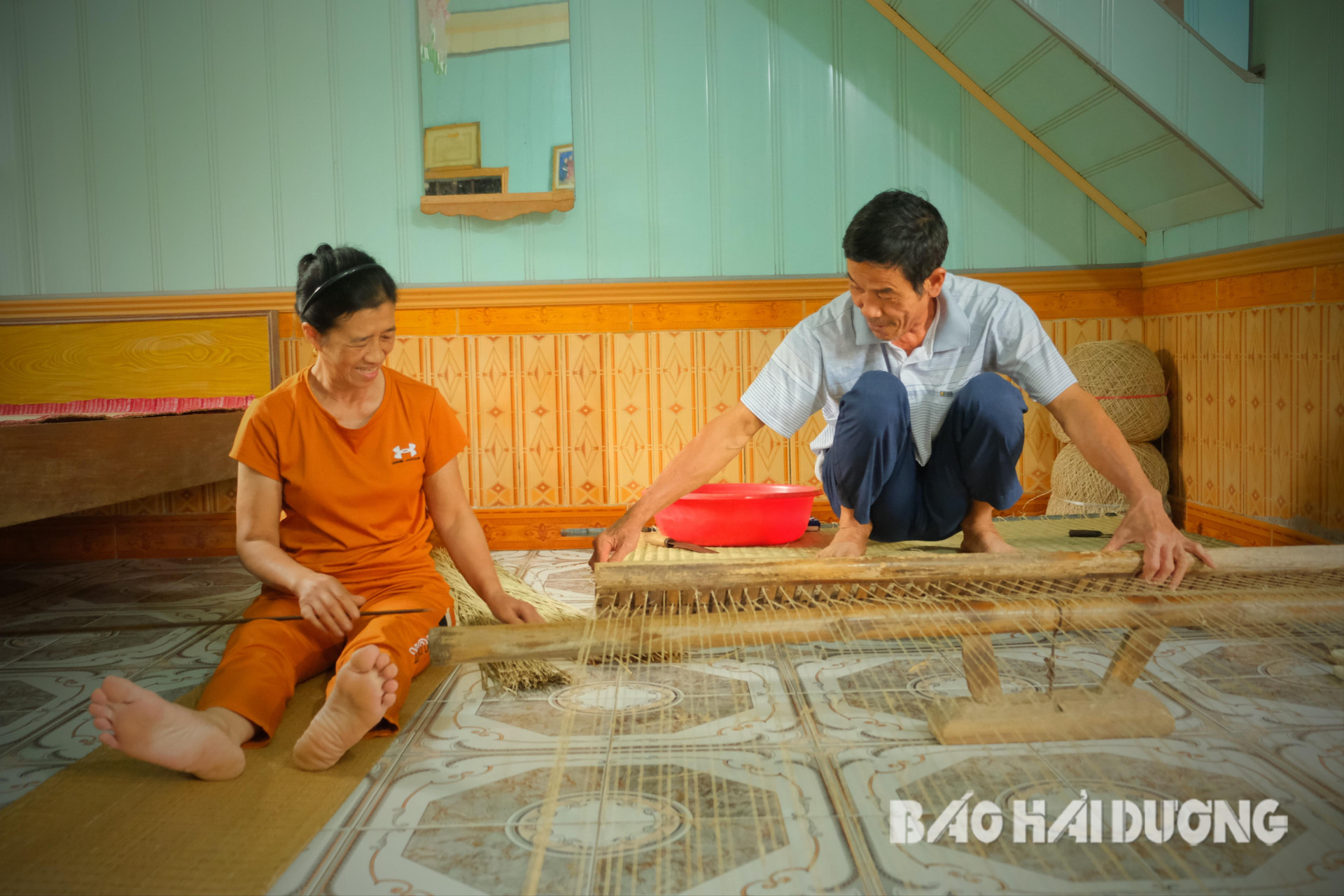From hundreds of looms creaking day and night, now the traditional craft village of Tien Kieu, Thanh Hong commune (Thanh Ha) only has a few looms that have become dull with time.

When the wife weaves, the husband weaves. Mr. Pham Van Thieu and his wife have had more than half a century of attachment to the traditional profession
“I’ll weave a pair of flower mats for you to spread in the middle of the house.”
It is rare for any traditional craft to enter poetry, music, or painting as much as mat weaving.
I weave a pair of flower mats/ Let you spread them in the middle of the house/ Invite your teacher and mother to come visit/ Let me talk/ Let me talk (Warm sunshine in the hometown of musician Vinh An). Or Help me with the mats I lie on/ The blankets I cover with, the blankets I wear… ( folk song )
Historically, Hai Duong had many mat weaving villages, such as Uong Thuong, Uong Ha, Chu Dau, Mac Xa of Thanh Lam district (present-day Nam Sach); Quang Uyen, Chu Uyen (Tu Ky), or Nga Hoang (now Phuong Hoang, Cam Hoang commune of Cam Giang district). But perhaps, Tien Kieu sedge mat craft village has the most enduring vitality and has been deeply ingrained in the memories of many generations of people here.
Unfortunately, in Thanh Hong commune there is no record of the birth of this craft village or who is the founder of the craft or who brought the mat weaving craft here. We only know that the profession of weaving sedge mats in Tien Kieu has existed for hundreds of years. In the past, 6-7 year old children knew how to roll sedge, roll colors, roll borders, tie jute, and spin yarn. At that time, specialty trees such as lychee and peach grapefruit had not yet developed in Thanh Hong, but the whole Tien Kieu village was filled with sedge fields. The sedge is green from inside the house all the way to the riverbank.
According to the experience of mat weavers, Thanh Hong’s raw sedge is sedge grown in freshwater areas, so it is soft, has a unique scent and makes very durable mats, unlike sedge in saltwater areas. . The people of Tien Kieu village choose varieties to make mats, which are round sedge plants with flexible, shiny fibers. This is also called “rice sedge”. Whenever the sedge field gradually turns from green to yellow, the sedge is ripe. Now, instead of the endless sedge fields at that time, there are areas growing lychees and grapefruit from the house to the alley, all the way to the Hanoi – Hai Phong highway running through the village.
During the heyday of mat weaving, Tien Kieu village had dozens of hectares of sedge cultivation. Now the area has shrunk, the whole village has only a few acres left planted in lychee gardens. Lychee and peach grapefruit are Thanh Hong’s specialty trees, bringing great revenue to the people. Therefore, the fields growing sedge are increasingly shrinking, as well as the mat weaving profession is increasingly disappearing..jpg)
In Tien Kieu village, there are only a few acres of raw sedge planted in specialty lychee gardens
Sedge in Tien Kieu is collected in 2 crops per year. The main crop is harvested in the 6th lunar month. The sedge in this crop is more beautiful and even than the “bad crop”. The “wrong crop” is collected in the 10th lunar month and is the sedge plant that grows on its own after people cut the roots of the crop in June. Now there is little sedge but this type of plant has more pests and diseases than before, so people Have to spray more pesticides and disease killers. There are not many raw materials left, every time a customer orders, people have to go to Thai Binh and Hai Phong to buy sedge, or some small traders buy container trucks to the village to gradually sell to mat weavers for 25,000 – 30,000 VND per kg of finished sedge.
Collected fresh sedge will be split in half, dried in the sun for 5 days and stored for later use. Each kilogram of fresh sedge when dried is only about 2 and a half ounces. When weaving mats, the dried sedge is soaked in water to soften it so that it does not break when weaving.
Mr. Pham Van Thieu is 65 years old this year. Born and raised in the village amid the day and night creaking sound of mat weaving looms, he has worked in the profession for more than 50 years. The mat weaving profession has been maintained by his family for hundreds of years, since his great-grandfather did it. Today, Mr. Thieu’s family still has a loom, but only makes mats when customers call to order. Mr. Thieu’s wife – Mrs. Nguyen Thi Khuyen was also born here and also worked as a mat weaver for many years.
In Tien Kieu, there are now only older people who work in leisure time. Absolutely no more images of young people weaving mats. Even though it is a profession they have been associated with since their grandfather’s time and has sustained them through the country’s difficult times, few people are passionate about it. Because the income from mat weaving cannot be compared with the salary when they work as workers for businesses around the area.
Mat weaving has entered poetry, music, and paintings, and the mat is closely tied to people from birth to death. From birth, the child was placed on a mat to crawl on the floor. In times of hardship, people who passed away were only able to get a copy of it and then bury it.
The mat is also present in every important event in a person’s life. In the past, wedding guests often brought a pair of flower mats as gifts for the bride and groom. Then, before entering the room with flowers and wishes, the homeowner must also choose someone to spread the mat. The person who has the honor of spreading the mat on the wedding bed must be a peaceful person, with a fulfilling and harmonious family life. The mat is also present in every important event of the country’s village. Village festivals are indispensable for flower mats spread in the middle of the communal house’s yard for old women to sit and chew betel, for old men to play tam chrysanthemums, shrimp nests…
Tien Kieu sedge mat once played such an important role!
Tien Kieu village is also known as Thieu village. The profession of weaving mats, even though there is no rain or sunshine, requires patience and diligence day and night at home. In the village, there is also a funny rhyme “Thieu village weaves deep mats”, talking about the hardships of the mat weavers.
.jpg)
Mr. Pham Van Thieu’s calloused hands have spent more than half a century working in the mat weaving profession
“I weave a pair of flower mats/ For you to spread in the middle of the house.” Weaving mats always involves pairs. No one weaves one mat, but usually weaves a pair. No one can weave mats alone, it takes 2 people.
Chao, go, horse, lui, are ancient words used by Tien Kieu people for hundreds of years to describe actions or refer to parts on the loom. Chao is the act of using a bamboo stick to thread a sedge thread into the loom through a row of jute ropes. The wife “chaos” the husband weaves. If you are meticulous like that, you will only get a pair of mats in the whole session.
Tien Kieu mats have many sizes, but mainly 1.3 m x 1.9 m; 1.5 m x 1.9 m and 1.6 m x 1.9 m. Each pair is sold for between 450,000 – 500,000 VND. It’s as simple as that, but getting a pair of finished mats takes a lot of work. After weaving, Tien Kieu mats are brought to the workshop in the village to have flowers printed, steamed and then exposed to 3 dew, 3 sun or 5 dew, 5 sun. This way we can produce a finished mat that can be used for 3-5 years before it breaks.
.jpg)
After weaving, Tien Kieu mats are brought to the workshop in the village to have flowers printed, steamed and then dried 3 dew, 3 sun or 5 dew, 5 sun.
Tien Kieu mats also have many types. Mats for eating and drinking water are made from large, hard sedge, while small, soft sedges are used to make sleeping mats. At the most prosperous time of the craft village, Tien Kieu sedge mats shine brightly in He market on the 5th, 10th, 15th, 20th, 25th and 30th days of the lunar calendar. Now Tien Kieu people no longer bring mats to the market, but usually have a small merchant collect them for sale. Although it is no longer crowded, Tien Kieu mat is still famous near and far. Every time my children who live far away come home, they buy mats as gifts. Some people who go abroad also bring mats to ease their nostalgia for their hometown.
Thanh Hong commune currently has only 11 households specializing in mat weaving. Even though the income is not high, many people still stick to the profession with the hope that the craft village will continue forever. The elders in Tien Kieu are always worried that when they are gone, who will be left to weave mats? Children today, instead of sitting next to the loom helping their parents weave mats and listening to their grandparents tell stories, are busy studying all day and no one is interested in traditional occupations. As Mr. Pham Van Thieu’s family mentioned above, even though he and his grandparents have had half a century of traditional craft, none of their children know how to weave.
To preserve traditional crafts, in 2020 Thanh Hong commune was supported by the Provincial People’s Committee with 4 billion VND to invest in building 3.7 km of roads to Tien Kieu and Nhan Bau traditional craft villages. The Commune People’s Committee organized site clearance. Villagers donated land to expand roads and build a drainage system. That route is now called Lang Craft Street.
Not born in Tien Kieu, only coming here to be a bride, but Ms. Nguyen Thi Ha, Vice President of the Farmers’ Association, Head of Thanh Hong Commune Radio Station as well as the elders in the village always want to maintain the traditional profession. . Even if it is not as good as it was in its most prosperous period, the Tien Kieu mat-weaving profession should not be lost, not just memories and stories!
News
GIO-WHIZZ Giovanni Pernice cheered on by A list pal and former Strictly partner after he ANNOUNCES HUGE CAREER MOVE
THE findings from a probe into Giovanni’s conduct is set to be released in days GIOVANNI Pernice’s huge career move is being celebrated by an A-list pal and a former Strictly dance partner. Last night the dancer revealed he will…
Strictly’s Pete Wicks insists Zara McDermott will be his ‘NUMBER ONE FAN’ because she ‘LOVES THE SHOW’ – after she was @BUSED by her partner Graziano Di Prima
Pete Wicks has insisted Zara McDermott ‘loves Strictly‘ and will be his ‘number one fan’ when he competes. The TOWIE star, 36, signed up for the show just days after it emerged his friend Zara, 27, was physically and verbally abused by her professional dance partner Graziano…
GOING FOR GOLD I’m NOT PHASED by Strictly controversy…I’m so excited to go on show DESPITE SCANDALS and Curse, says Tasha Ghouri
Plus, why Tasha and Andrew are not worried about the dreaded Strictly Curse in the slightest THERE’S no denying Strictly Come Dancing has been weathering the toughest challenge of its 20-year existence. The much-loved BBC1 show has been thrown into turmoil…
Amanda Abbington is ‘DEEPLY DISAPPOINTED’ with BBC bosses over fears they are ‘PROTECTING’ Giovanni Pernice amid Strictly BULLY!NG PR0BE
Amanda Abbington is ‘deeply disappointed’ with BBC bosses over fears their ‘protecting’ Giovanni Pernice amid bullying probe. Sherlock actress Amanda, 50, has made a series of accusations about her pro Giovanni Pernice’s teaching methods and has described his behaviour as ‘unnecessary, abusive, cruel and mean’. He…
Kate Garraway apologises for ‘BAD QUESTION’ to Grenfell victim on Good Morning Britain
Kate Garraway swiftly offered an apology on Good Morning Britain following her chat with guest Sawsan Choucair. During the segment, Kate and co-host Ed Balls talked to Sawsan, who suffered the heartbreaking loss of six family members in the 2017…
STILL DANCING Giovanni Pernice ANNOUNCES new job after Strictly Come Dancing EXIT as BBC is set to RELEASE PR0BE FINDINGS
The star has shrugged off the news by revealing his new job on Instagram GIOVANNI Pernice has brushed off the Strictly scandal by landing a new job on the Italian version of the show. Giovanni, who quit Strictly Come Dancing in May…
End of content
No more pages to load











